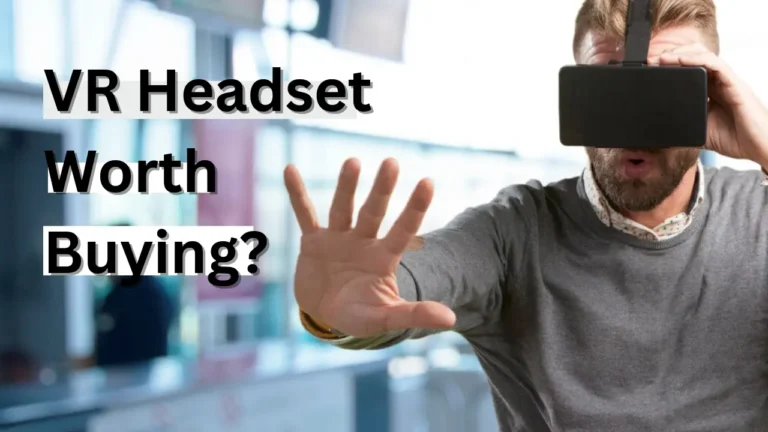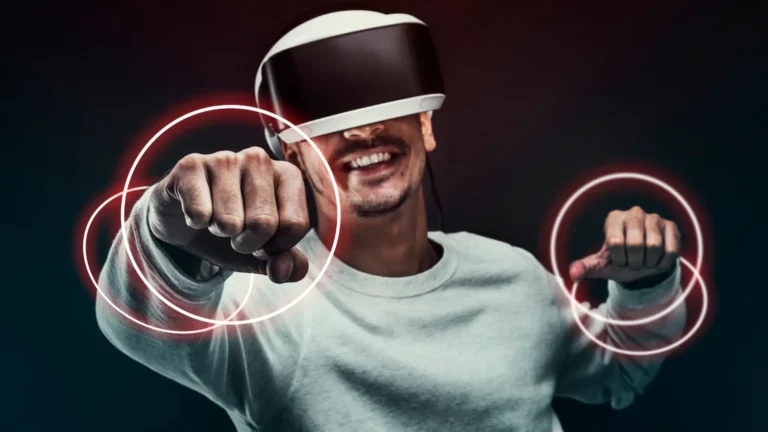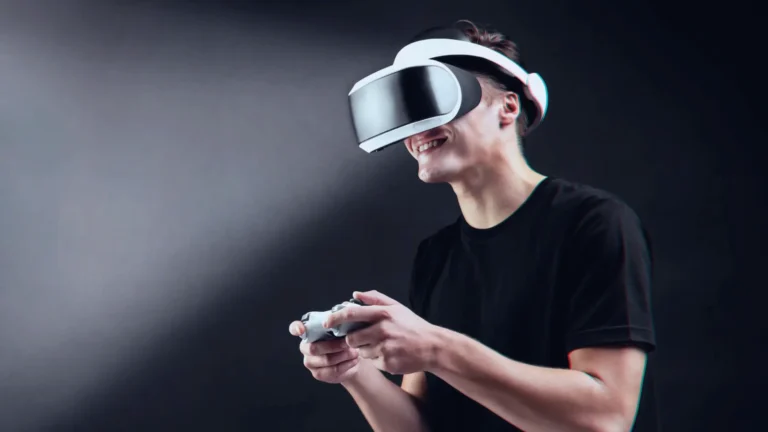How businesses can use Virtual Reality marketing to Grow
Here are the best some of the best ways you can implement VR marketing to grow your business and get more customers. Virtual reality (VR) is a technology with the potential to transform the way businesses approach marketing. VR enables the development of immersive and interactive experiences that engage customers in novel and interesting ways. VR has the potential to improve marketing efforts and boost corporate growth across the board, from advertising and product demos to trade exhibitions and training. In this blog article, we will look at how businesses may utilize virtual reality to improve their marketing efforts, as well as some of the obstacles and possibilities that this technology brings.
We will also look at some examples of businesses that have effectively used VR in their marketing plan. Whether you’re a company owner, marketer, or simply interested in the possibilities of virtual reality, this post will give vital insights into how this technology may be used to generate development and success.
Introduce the concept of virtual reality and its potential impact on business marketing
Virtual reality (VR) is a technology that allows people to interact with a three-dimensional computer-generated simulation. It may be used for many different things, including gaming, entertainment, and education. A headset, such as the Oculus Rift or the HTC Vive, shows the simulated environment and records the user’s head movements, allowing them to gaze about and interact with the virtual world.
Virtual reality technology is already making an impact in the sphere of commercial marketing. VR can help businesses engage customers in new and intriguing ways by delivering immersive and engaging experiences. It can be used to create advertising campaigns that transport customers to a brand’s world, product demonstrations that provide customers with a realistic experience of a product before purchasing, trade shows and events that provide interactive and engaging experiences, and more immersive and effective training and education programmes. Virtual reality has the potential to have a massive influence on company marketing. It provides a fresh approach for firms to stand out in the marketplace and separate themselves from their competitors. Furthermore, it may assist organizations in strengthening client connections, increasing brand recognition, building trust with their customer, and more.
Virtual Reality in Advertising
Now let’s look at the possibilities of VR in advertising and how can a business integrate VR for effective marketing and better return on capital. So let’s being now

How virtual reality can be used to create immersive advertising experiences
VR technology may be used to create immersive advertising experiences that transport people to the world of a business and engage them in novel and interesting ways. VR enables businesses to build advertisements that go beyond the typical 2D style, providing customers with a more realistic, engaging, and memorable experience.
Businesses may utilise virtual reality in advertising by building virtual reality experiences that display their products or services. Now let’s talk about a vehicle manufacturer, for example, that may provide a virtual test drive experience that lets buyers explore the automobile’s features and capabilities in a realistic and engaging manner. This provides buyers with a greater understanding of the product and its value, which may assist to develop trust and enhance the possibility of a purchase.
Another option for businesses to utilise virtual reality in advertising is to create virtual reality experiences that transport clients to the world of the brand. A travel operator, for example, might design a virtual reality experience that allows clients to explore several places and get a taste of what it would be like to travel with them. This can promote enthusiasm and anticipation, which can lead to more reservations.
Furthermore, VR may be utilised to create brand experiences that are unrelated to the product or service being sold. A fast-food franchise, for example, may design a virtual reality experience that allows guests to enter the restaurant’s kitchen, meet the chefs, and learn about the food preparation process. This may aid in the creation of a favorable image and a memorable experience that customers will identify with the business.
Overall, virtual reality technology has the ability to transform how organisations approach advertising by producing immersive and interactive experiences that engage customers in novel and interesting ways. Businesses may develop trust and boost the possibility of a sale by letting customers experience products and services in a realistic and engaging manner, as well as create a memorable and enjoyable experience for customers.
Examples of companies that have already implemented VR in their advertising campaigns
Several businesses have already used virtual reality (VR) in their advertising efforts. Here are a few examples:
IKEA using VR: The furniture company developed a virtual reality programme that allows buyers to view how furniture might appear in their own homes before purchasing it. Customers may even stroll through virtual replicas of IKEA shops using the app.
Mercedes-Benz using VR: The automaker designed a virtual reality experience that allowed consumers to test drive the Mercedes-Benz AMG GT on a racing circuit. This experience was available at certain Mercedes-Benz dealerships and allowed consumers to get a feel for the car’s performance and handling before purchasing it.
Coca-Cola using VR: The beverage corporation produced a virtual reality experience that allowed customers to learn about the history and production of Coca-Cola. The experience was accessible in select Coca-Cola vending machines and required a specific code to access.
Tourist Australia using VR: The national tourism agency developed a virtual reality (VR) experience that allows clients to see several locations of Australia, including the Great Barrier Reef and Uluru. The experience was provided at certain travel companies and contributed to the creation of excitement and anticipation.
McDonald’s using VR: The fast-food corporation developed a virtual reality experience that allowed consumers to enter the McDonald’s kitchen and learn about the food preparation process. The event was accessible at certain McDonald’s restaurants and contributed to a favourable image and a memorable customer experience.
These are just a few examples of organisations that have used VR in their advertising efforts many more companies from other industries and sectors have begun to use VR in their marketing strategy. As technology evolves and becomes more accessible, it is probably that more firms will begin to investigate the possibilities of VR in their advertising efforts.
Is Virtual Reality (VR) Headset Bad For Your Eyes Long-Term?
Virtual Reality in Product Demonstrations
Customers may get a realistic experience of a product before purchasing it using virtual reality (VR) technology. Product demos are an important part of the sales process, and businesses can use VR technology to create immersive and interactive experiences that help buyers understand the product and its value. This can help to boost trust and the chance of a transaction. VR may be used to display items in a variety of industries, including electronics, fashion, home appliances, real estate, and others. Businesses may separate themselves from the competition and create a memorable and pleasant experience for customers by letting them to experience items in a realistic and engaging manner.
How virtual reality can be used to give customers a realistic experience of a product before purchasing
Before purchasing a product, buyers may have a realistic experience with virtual reality (VR) technology. This may be achieved by developing immersive and interactive product demos that allow clients to explore the features and capabilities of the product in a realistic and interactive manner. This can help to boost trust and the chance of a transaction. VR may be used to display items in a variety of industries, including electronics, fashion, home appliances, real estate, and others. It may also be used to show items that would be difficult or impossible to show in the actual world. Overall, virtual reality technology has the potential to transform the way organisations approach product presentations, resulting in memorable and good consumer experiences.
Virtual Reality in Trade Shows and Events
At trade exhibitions and events, virtual reality (VR) technology may be utilised to create interactive and engaging experiences. Businesses may separate themselves from the competition and create a memorable and enjoyable experience for attendees by allowing guests to experience products and services in a realistic and engaging manner.

Businesses may employ virtual reality at trade exhibitions and events by building virtual reality experiences that highlight their products or services. A vehicle manufacturer, for example, may design a virtual test drive experience that allows participants to explore the automobile’s features and capabilities in a realistic and engaging manner. This helps participants to have a greater understanding of the product and its value, which may aid in the development of trust and enhance the possibility of purchase.
How virtual reality can be used to create interactive and engaging experiences at trade shows and events
Businesses may separate themselves from the competition and create a memorable and pleasant experience for visitors by allowing guests to experience products and services in a realistic and interactive way using virtual reality (VR) technology at trade fairs and events.
Businesses may employ virtual reality at trade exhibitions and events by building virtual reality experiences that highlight their products or services. A vehicle manufacturer, for example, may design a virtual test drive experience that allows participants to explore the automobile’s features and capabilities in a realistic and engaging manner. This helps participants to have a greater understanding of the product and its value, which may aid in the development of trust and enhance the possibility of purchase.
Furthermore, in the real estate market, firms may utilise VR to provide visitors with a virtual tour of homes, allowing them to explore the property and get a feel of what it would be like to live there, which can assist to develop enthusiasm and enhance the possibility of a sale.
Think of this as if you are a customer getting the feal of the product before you buy can help you decide what to buy and what not and as a business, it can help customers bettering understanding their product and no confusion while buying.
Another method for businesses to use VR at trade fairs and events is to create virtual reality experiences that immerse participants in the world of the brand. A travel business, for example, may design a virtual reality experience that allows participants to tour several places and get a taste of what it would be like to travel with them. This can promote enthusiasm and anticipation, which can lead to more reservations.
Virtual Reality in Training and Education
VR technology may be utilised to deliver immersive training and educational experiences. Virtual reality (VR) allows users to interact with a computer-generated simulation of a three-dimensional world, which may be used to imitate real-life settings and circumstances. This can improve the engagement, interaction, and effectiveness of training and education.
Businesses may employ virtual reality in training by building virtual reality experiences that mirror real-life settings and circumstances. A medical business, for example, might design a VR experience that allows medical students to practise surgical operations in a realistic and interactive setting. This can aid in the development of skills and confidence in a safe and regulated atmosphere.
For example, Nowadays most people do not have and condition to visit events away from their house, and by using VR training they can take training or attend the event from the rest of their homes without traveling headache. No, stay issue no travel issue. They can save more time.

Businesses may also employ VR in education by producing virtual reality experiences that transfer students to different locations and times. A history instructor, for example, may build a VR experience that allows pupils to tour ancient Egypt and learn about its culture, history, and architecture. This can improve learning by making it more interesting, interactive, and remembered.
How virtual reality can be used to provide immersive training and educational experiences
VR technology can be utilised to deliver immersive training and educational experiences. Virtual reality (VR) allows users to interact with a computer-generated simulation of a three-dimensional world, which may be used to imitate real-life settings and circumstances. This can improve the engagement, interaction, and effectiveness of training and education.
Furthermore, virtual reality (VR) can be used in professional training, such as in the medical field, where medical students can practice surgical procedures in a realistic and interactive environment, or in the military, where soldiers can practice combat scenarios in a safe and controlled environment.
Overall, virtual reality technology has the potential to transform the way organisations approach training and education by delivering immersive and interactive experiences that make learning more interesting, effective, and memorable. It enables people to practice and experiment with real-life circumstances in a safe and controlled setting, which can lead to improved information retention and skill development.
Opportunities available in VR for businesses
Virtual reality (VR) technology provides businesses with several chances to engage clients in novel and interesting ways. VR can help businesses stand out in the marketplace and separate themselves from the competition by offering immersive and engaging experiences.
The capacity to create immersive advertising experiences is one advantage that VR provides firms. Businesses may use VR to develop advertisements that go beyond the typical 2D format and provide clients with a more realistic, engaging, and memorable experience. This can assist to raise brand awareness and memory, as well as promote sales.
Overall, virtual reality technology allows businesses to connect customers in novel and interesting ways, from advertising to product demos, trade exhibitions, and events to training and education. It enables businesses to create immersive and engaging experiences that may help them stand out in the marketplace and strengthen consumer connections.
More to read:
How To Watch Movies In Virtual Reality Headset
Are Virtual Reality Headsets Worth Buying In 2023
Can The Metaverse Replace The Real World? Metaverse Vs Real World
Conclusion
VR technology has the ability to transform the way organisations approach client interaction. VR can help businesses stand out in the marketplace and separate themselves from the competition by offering immersive and engaging experiences. VR may be used to create immersive advertising experiences, realistic product presentations, interactive and engaging experiences at trade exhibitions and events, and immersive training and educational experiences, among other things.
The use of virtual reality in advertising enables firms to produce advertisements that go beyond the typical 2D format, providing customers with a more realistic and engaging experience, which may assist to enhance brand awareness and recall and drive sales. VR may be used in product presentations to provide buyers with a realistic experience of a product before they buy it, which can assist to establish trust and enhance the chance of a sale. VR may also be utilised to create interactive and engaging experiences that help separate businesses from the competition and provide a memorable and positive experience for guests at trade exhibitions and events.






It’s very interesting!